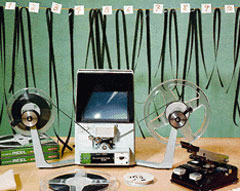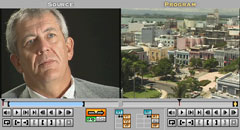|
Editing
> Introduction
|

ABOVE: No, you won't have to physically
cut and splice strips of film. Those
days are over. Be thankful, it was
a real pain!
BELOW: Today, most editing (but
not all) is done on a computer.

|
|
|
It
might seem odd to begin a television production class
with a unit on editing. But I believe it is the most
logical way to learn the television production process.
In the old Hollywood studio system, beginners almost
always started out as assistant editors. Film executives
understood that once you grasped the concepts of editing,
it was much easier to learn camera work or directing
or sound, etc.
That’s
because editing is the very core of the television production
process. The editing room is where television programs
are built. This is counterintuitive for a lot of beginners.
They often assume that camera work is the centerpiece
of the production process. But that error in thinking
is the reason that many beginners create boring, unwatchable
programs.
The
first thing you must understand is that editing is NOT
"cutting out the bad parts" as many people
assume. Rather editing is the process of assembling
a program from the ground up—by artfully blending
images and sound to create a coherent whole.

|